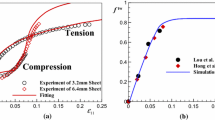Abstract
In order to determine the deformation modes in AZ31 magnesium alloy at room temperature, computer simulations of deformation texture development and calculation of formability have been carried out. The simulation results were compared with the measured texture results. Based on agreement between the experiments and simulations the active deformation modes were determined. A Visco Plastic Self Consistent model was employed for the simulation of plastic deformation. Simulations and experiments were performed for different initial textures. The goal of the study was to develop the understanding of deformation texture evolution and its effects on mechanical properties of magnesium, with an ultimate goal of improving room temperature formability of magnesium alloys.







Similar content being viewed by others
References
Hertzberg R.W. (1995) Deformation and Fracture Mechanics of Engineering Materials, 4th edition. John Wiley & Sons, Inc. New York
Mohamed F.A. (2001) The Role of Boundaries During Superplastic Deformation. Surf. Interface Anal. 31:532–546
Mwembela A., Konopleva E.B., McQueen H.J. (1997) Microstructural Development in Mg Alloy AZ31 during Hot Working. Scripta Mater. 37(11):1789
Solberg J.K., Tørklep J., Bauger O., Gjestland H. (1991) Superplasticity in Magnesium Alloy AZ91. Mater. Sci. Eng. A134:1201
Yamashita A., Horita Z., Langdon T.G. (2001) Improving the Mechanical Properties of Magnesium and a Magnesium Alloy Through Severe Plastic Deformation. Mater. Sci. Eng. A300:142
Takuda H., Kikuchi S., Hatta N. (1992) Possibility of Grain Refinement for Superplasticity of a Mg-AI-Zn Alloy by Pre-deformation. J. Mater. Sci. 27:937
Bussiba A., Artzy A.B., Shtechman S., Ifergan M. (2001) Grain Refinement of AZ31 and ZK60 Mg Alloys—Towards Superplasticity Studies. Mater. Sci. Eng. A302:56
Watanabe H., Mukai T., Ishikawa K., Mabuchi M., Higashi K. (2001) Realization of High-Strain-Rate Superplasticity at Low Temperatures in a Mg-Zn-Zr Alloy. Mater. Sci. Eng. A307:119
del Valle J.A., Pérez-Prado M.T., Ruano O.A. (2003) Texture Evolution During Large-Strain Hot Rolling of the Mg AZ61 Alloy. Mater. Sci. Eng. A355:68
Styczynski A., Hartig C., Bohlen J., Letzig D. (2004) Cold Rolling Textures in AZ31 Wrought Magnesium Alloy. Scripta Mater. 50:943
Agnew S.R., Yoo M.H., Tome C.N. (2001) Application of Texture Simulation to Understanding Mechanical Behavior of Mg and Solid Solution Alloys Containing Li or Y. Acta Mater. 49:4277
Lebensohn R.A., Tome C.N. (1993) A Self-consistent Anisotropic Approach for the Simulation of Plastic Deformation and Texture Development of Polycrystals—Application to Zirconium Alloys. Acta Metall. 41:2611
Tome C.N., Lebensohn R.A., Kocks U.F. (1991) A Model for Texture Development Dominated by Deformation Twinning Application to Zirconium Alloys. Acta Metall. Mater. 39:2667
Bunge H.J. (1982) Texture Analysis in Materials Science. Butterworth, London
Barnetta M.R., Navea M.D., Bettlesb C.J. (2004) Deformation Microstructures and Textures of Some Cold Rolled Mg Alloys. Mater. Sci. Eng. A386:205
Roberts C.S. (1960) Magnesium and its Alloys Wiley, New York, 180
Acknowledgments
The authors thank Paul Krajewski of GM R&D for reviewing the manuscript and for many helpful suggestions, and gratefully acknowledge the financial support from General Motors of Canada and the Natural Sciences and Engineering Research Council of Canada.
Author information
Authors and Affiliations
Corresponding author
Rights and permissions
About this article
Cite this article
Li, H., Hsu, E., Szpunar, J. et al. Determination of Active Slip/Twinning Modes in AZ31 Mg Alloy Near Room Temperature. J. of Materi Eng and Perform 16, 321–326 (2007). https://doi.org/10.1007/s11665-007-9051-1
Received:
Accepted:
Published:
Issue Date:
DOI: https://doi.org/10.1007/s11665-007-9051-1




